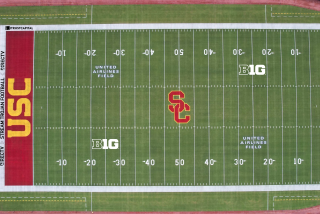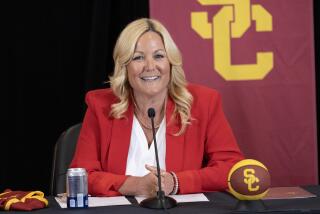A New Chapter in College Texts Will Begin at UCSD : Education: McGraw-Hill deal will allow faculty to create customized books by computer in mere hours.
- Share via
SAN DIEGO — In the first such effort at any university, UC San Diego professors will soon be able to order customized books from a menu of texts and journals stored in a campus computer--then have them printed, bound and available in the campus bookstore within hours.
The agreement, to be announced today between UCSD and McGraw-Hill of New York, one of the nation’s largest publishers of academic texts and journals, will take on-demand electronic printing to its most advanced campus marketing test yet. USC will begin a similar experiment early next year with the same system.
The arrangements represent the latest technological wrinkle in a rapid revolution involving the gathering and distribution of information at the nation’s universities. The new system promises fresher, more relevant information for college texts, an end to copyright problems and quicker professor access to writings.
Among related advances, San Diego State University is about to enter into a database all book and journal excerpts required by professors for their courses, so that students will be able to call up the excerpts on computer terminals in library reserve areas and make individual printouts.
At USC, the Center for Scholarly Technology is experimenting with a variety of systems to work out problems of speed, quality and copyright law. The center is also working on ways to get students and professors to accept and use text from computers rather than paper.
The Assn. of Research Libraries in Washington has formed a coalition with publishers and others to push for standardized technology so that the increasing number of uses that come on line will be compatible with each other.
“What we’re seeing today is only the birth of what will bring a wealth of new ways that libraries and others must adapt to,” said Peter Lyman, associate dean for library technology at USC.
“If you start peeling this onion, you’ll be amazed at the possibilities you’ll find,” he said.
Under the latest arrangement, McGraw-Hill will make available on a database known as Primis an extensive inventory of its texts and journals. Within the next several months, professors will be able to use a terminal in the UCSD bookstore to mix and match chapters, articles and even unpublished manuscripts into a cohesive textbook.
For example, a professor teaching a course on modern European politics can choose up-to-the-minute material encompassing all of the changes in that part of the world--rather than having to rely on a standard text hopelessly out of date no matter how recently it was published.
After professors make their selections, the bookstore will transmit the order to a high-speed printer in the UCSD graphics shop, where as many as 90 pages of book-quality type can be printed every minute. There, within hours, the selections will be printed, bound and put out for sale.
The system could eventually be expanded so that professors can put orders together from their own office computers.
Until now, the McGraw-Hill customized system required professors at various universities to send requests to the publishing company, which then arranged the texts and shipped them back to the campus.
Robert Meigs, an accounting professor at SDSU, put together the first custom text under the system last year, and his handiwork is used across the country.
“It’s particularly good in that you can revise or update material at any time and not wait the traditional two or three years necessary with regular texts,” he said. “And going on-line, letting the professors themselves assemble the materials, that’s even more of a benefit for (the) faculty.”
Robert Lynch, who heads the Primis project for McGraw-Hill, said publishers “are being told by customers, i.e., professors, that they want more control over the way they can have information available to their students, and in a timely manner.
“They don’t want it predetermined by a publisher” who presents them with a text and says, “This is what you get,” he said.
“We were finding more and more that we were developing more and more supplements for texts, that this or that part of the country, or this or that university, was demanding something different from others, and that textbooks were growing and growing in size,” Lynch said.
Laura Long, an assistant vice chancellor for business services at UCSD, said the university invested about $400,000 in computer and printing equipment for the project but that McGraw-Hill waived the first-year fees for the “language” to run the system. The price of the customized texts will include royalty costs of the books and journals involved, as determined by McGraw-Hill, as well as a profit for the campus bookstore.
USC’s Lyman said a major issue now is whether these texts will be cheaper than traditional textbooks and whether they will be as convenient as simply having copy shops reproduce desired pages from publications.
But Lyman emphasized that the Primis system offers a way to deal with copyright problems now plaguing professors who have gone the copy shop route.
Kinko’s Graphics Corp., a Ventura-based national chain of copy shops, was successfully sued last spring by eight major publishers for violating copyrights by reproducing and binding tens of thousands of professor-produced custom anthologies, without first obtaining permission from the authors.
As a result, many professors around the country discovered this fall that copy shops were returning their course packets with missing articles because there was no proof that copyright permission had been obtained. That is part of the reason for SDSU’s new system, which allows students to make individual copies of articles or chapters, then records the transaction to give publishers a mechanism for receiving royalties.
The new technology also gives faculty members quicker, easier access to the latest written material and eliminates the time-consuming task of compiling documents from several libraries or databases, USC’s Lyman said.
“And the product will be of a much higher quality than are copies,” Lyman said.
But, in order for the project to succeed fully, other publishers must either become part of the McGraw-Hill system through a cooperative venture or set up their own databases. Most professors will want materials from a variety of publishers.
“That is a barrier to enormously widespread use at present,” Meigs of SDSU said.
“You’ll have to get other publishers, and that means trying to get cooperation on (computer language and printing) standards,” said Long of USCD.
Eventually that will happen, said McGraw-Hill’s Lynch, “because the reader, the professor, everyone will demand it.”
“If you look at the longer term, then the public good is best served by sharing information, and the best models would encompass that,” said Chuck Grycz, who heads a project on scholarship and technology for the University of California’s Office of the President.
Grycz and Lyman listed a number of larger questions beyond on-demand printing that planners face in peering into the electronic future.
How will libraries decide what new materials to store electronically and what to put in print, especially since the number of journals available only on databases is increasing? How will users react to browsing through computer menus rather than library stacks? How can libraries and professional societies ensure the academic validity of material that can be disseminated electronically without going through normal academic review?
“In order to take advantage of all the experiments, we’re going to have to coordinate them,” Grycz said, noting as an example a new project by the University of California to store an electronic journal put out by the American Assn. for the Advancement of Science and then determine who uses it. Similarly, USC has put the “Chronicle of Higher Education”--a journal devoted to news and job listings at American universities and colleges--on a database to explore the popularity of electronic access.
“Technologically, a lot of things are possible, but a lot of economic incentives will have to be in place first before they will become widespread,” Lyman said. “Are there incentives to go beyond electronic storage of instructional materials--which are refreshed once or twice a year--as opposed to putting on electronic storage a journal that’s used once every 60 years?”
More to Read
Sign up for Essential California
The most important California stories and recommendations in your inbox every morning.
You may occasionally receive promotional content from the Los Angeles Times.













